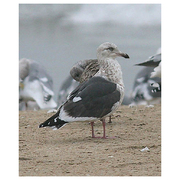Slaty-backed Gull
The Washington representatives of this family can be split into two groups, or subfamilies. The adaptable gulls are the most familiar. Sociable in all seasons, they are mainly coastal, but a number of species also nest inland. Many—but not all—are found around people. Gulls have highly variable foraging techniques and diets. Terns forage in flight, swooping to catch fish or insects. They dive headfirst into the water for fish. Although they are likely to be near water, they spend less time swimming than gulls.
General Description
This rare winter visitor is the same size as the Western Gull, which it also resembles in structure and general appearance. The adult has pink legs and a mantle a shade darker than our local race of Western Gull’s, although mantle color can be tricky to judge under field conditions. The head, neck, and upper breast are streaked in winter, whereas those of the Western Gull remain immaculate white (but beware of Western Gull x Glaucous-winged Gull hybrids, common in western Washington, which may have variable amounts of streaking in winter plumage). The eye of the adult Slaty-backed is usually but not always pale, rather like Herring Gull’s, while that of our northern race of Western Gull is usually but not always dark. In flight, the adult Slaty-backed shows less black, and more white, in the wingtips than Western and a relatively broader white trailing edge of the wing. [N.B.: The above descriptions are oversimplified. Field guides should be consulted—even more so for the immature plumages of the first three years of the bird’s life.]
A coastal resident of the northwest Pacific, the Slaty-backed Gull breeds from Siberia to northern Japan and winters from Japan south to Taiwan and east through the Bering Sea region to Alaska. Small numbers have bred in Alaska in recent years, and the species now shows up regularly in winter farther south along the West Coast. Washington’s first record was in 1986. The state now has 10 accepted records between mid-December and mid-March. All are from the Puget Lowlands, often at river mouths. Oregon has several records along the lower Columbia River, and Slaty-backed Gull is now annual in British Columbia.
Revised June 2007
Family Members
 Laughing GullLarus atricilla
Laughing GullLarus atricilla Franklin's GullLarus pipixcan
Franklin's GullLarus pipixcan Little GullLarus minutus
Little GullLarus minutus Black-headed GullLarus ridibundus
Black-headed GullLarus ridibundus Bonaparte's GullLarus philadelphia
Bonaparte's GullLarus philadelphia Heermann's GullLarus heermanni
Heermann's GullLarus heermanni Black-tailed GullLarus crassirostris
Black-tailed GullLarus crassirostris Short-billed GullLarus canus
Short-billed GullLarus canus Ring-billed GullLarus delawarensis
Ring-billed GullLarus delawarensis California GullLarus californicus
California GullLarus californicus Herring GullLarus argentatus
Herring GullLarus argentatus Thayer's GullLarus thayeri
Thayer's GullLarus thayeri Iceland GullLarus glaucoides
Iceland GullLarus glaucoides Lesser Black-backed GullLarus fuscus
Lesser Black-backed GullLarus fuscus Slaty-backed GullLarus schistisagus
Slaty-backed GullLarus schistisagus Western GullLarus occidentalis
Western GullLarus occidentalis Glaucous-winged GullLarus glaucescens
Glaucous-winged GullLarus glaucescens Glaucous GullLarus hyperboreus
Glaucous GullLarus hyperboreus Great Black-backed GullLarus marinus
Great Black-backed GullLarus marinus Sabine's GullXema sabini
Sabine's GullXema sabini Black-legged KittiwakeRissa tridactyla
Black-legged KittiwakeRissa tridactyla Red-legged KittiwakeRissa brevirostris
Red-legged KittiwakeRissa brevirostris Ross's GullRhodostethia rosea
Ross's GullRhodostethia rosea Ivory GullPagophila eburnea
Ivory GullPagophila eburnea Least TernSternula antillarum
Least TernSternula antillarum Caspian TernHydroprogne caspia
Caspian TernHydroprogne caspia Black TernChlidonias niger
Black TernChlidonias niger Common TernSterna hirundo
Common TernSterna hirundo Arctic TernSterna paradisaea
Arctic TernSterna paradisaea Forster's TernSterna forsteri
Forster's TernSterna forsteri Elegant TernThalasseus elegans
Elegant TernThalasseus elegans

